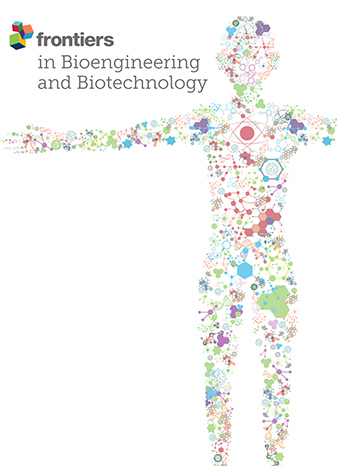The biomechanical evaluation of metacarpal fractures fixation methods during finger movements: a finite element study
IF 4.3
3区 工程技术
Q1 BIOTECHNOLOGY & APPLIED MICROBIOLOGY
引用次数: 0
Abstract
ObjectiveThis study used finite element analysis to simulate four commonly used fixation methods for metacarpal shaft oblique fractures during finger motion and evaluate their biomechanical performance. The aim was to provide evidence for clinically selecting the optimal fixation method, guiding early rehabilitation treatment, and reducing the risk of complications.MethodsFinite element analysis simulated dynamic proximal phalanx motion (60° flexion, 20° extension, 20° adduction, and 20° abduction). We analysed stress, displacement, and distributions for dorsal plates, intramedullary nails, Kirschner wire, and screw fixation methods.ResultsAt 60° of finger flexion and 20° of abduction, plate fixation demonstrated greater stability and minimal displacement, with a peak displacement of 0.19 mm; however, it showed higher stress levels in all motion states, increasing the risk of failure. The stability of the intramedullary nail was similar to that of the dorsal plate, with a maximum displacement difference of 0.04 mm, and it performed better than the dorsal plate during adduction of 20°. Kirschner wire showed the highest stress levels of 81.6 Mpa during finger flexion of 60°, indicating a greater risk of failure and unstable displacement. Screws had lower stress levels in all finger motion states, reducing the risk of failure, but had poorer stability. Stress and displacement distributions showed that the dorsal plate, intramedullary nail, and Kirschner wire mainly bore stress on the implants, concentrating near the fracture line and the proximal metacarpal. In contrast, the screws partially bore stress in the screw group. The anterior end of the metacarpal mainly hosted the maximum displacement.ConclusionThis study demonstrates that under simulated finger motion states, the dorsal plate fixation method provides the best stability in most cases, especially during finger flexion and abduction. However, high stress levels also indicate a higher risk of failure. The intramedullary nail is similar to the dorsal plate in stability and performs better in certain motion states. Kirschner wire exhibits the highest risk of failure during flexion. Although screws have poorer stability in some motion states, they offer a lower risk of failure. These findings provide important reference and surgical selection strategies for treating metacarpal fractures.手指运动时掌骨骨折固定方法的生物力学评估:有限元研究
目的 本研究采用有限元分析法模拟了掌指关节斜形骨折在手指运动过程中的四种常用固定方法,并对其生物力学性能进行了评估。方法通过有限元分析模拟近节指骨的动态运动(屈曲 60°、伸展 20°、内收 20°、外展 20°)。我们分析了背板、髓内钉、Kirschner钢丝和螺钉固定法的应力、位移和分布情况。结果在手指屈曲60°和外展20°时,背板固定法表现出更高的稳定性和最小的位移,峰值位移为0.19毫米;但在所有运动状态下,背板固定法表现出更高的应力水平,增加了失败的风险。髓内钉的稳定性与背板相似,最大位移差为0.04毫米,在外展20°时,髓内钉的表现优于背板。在手指屈曲 60°时,Kirschner 钢丝的应力水平最高,达到 81.6 兆帕,这表明其失效和不稳定位移的风险更大。螺钉在所有手指运动状态下的应力水平都较低,降低了失效风险,但稳定性较差。应力和位移分布显示,背板、髓内钉和 Kirschner 线主要对植入物产生应力,集中在骨折线和掌骨近端附近。相反,在螺钉组中,螺钉承受了部分应力。结论本研究表明,在模拟手指运动状态下,背板固定法在大多数情况下具有最佳稳定性,尤其是在手指屈曲和外展时。然而,高应力水平也预示着更高的失败风险。髓内钉的稳定性与背板类似,在某些运动状态下表现更好。Kirschner 线在屈曲时的失效风险最高。虽然螺钉在某些运动状态下稳定性较差,但其失效风险较低。这些发现为治疗掌骨骨折提供了重要的参考和手术选择策略。
本文章由计算机程序翻译,如有差异,请以英文原文为准。
求助全文
约1分钟内获得全文
求助全文
来源期刊

Frontiers in Bioengineering and Biotechnology
Chemical Engineering-Bioengineering
CiteScore
8.30
自引率
5.30%
发文量
2270
审稿时长
12 weeks
期刊介绍:
The translation of new discoveries in medicine to clinical routine has never been easy. During the second half of the last century, thanks to the progress in chemistry, biochemistry and pharmacology, we have seen the development and the application of a large number of drugs and devices aimed at the treatment of symptoms, blocking unwanted pathways and, in the case of infectious diseases, fighting the micro-organisms responsible. However, we are facing, today, a dramatic change in the therapeutic approach to pathologies and diseases. Indeed, the challenge of the present and the next decade is to fully restore the physiological status of the diseased organism and to completely regenerate tissue and organs when they are so seriously affected that treatments cannot be limited to the repression of symptoms or to the repair of damage. This is being made possible thanks to the major developments made in basic cell and molecular biology, including stem cell science, growth factor delivery, gene isolation and transfection, the advances in bioengineering and nanotechnology, including development of new biomaterials, biofabrication technologies and use of bioreactors, and the big improvements in diagnostic tools and imaging of cells, tissues and organs.
In today`s world, an enhancement of communication between multidisciplinary experts, together with the promotion of joint projects and close collaborations among scientists, engineers, industry people, regulatory agencies and physicians are absolute requirements for the success of any attempt to develop and clinically apply a new biological therapy or an innovative device involving the collective use of biomaterials, cells and/or bioactive molecules. “Frontiers in Bioengineering and Biotechnology” aspires to be a forum for all people involved in the process by bridging the gap too often existing between a discovery in the basic sciences and its clinical application.
文献相关原料
| 公司名称 | 产品信息 | 采购帮参考价格 |
|---|
 求助内容:
求助内容: 应助结果提醒方式:
应助结果提醒方式:


